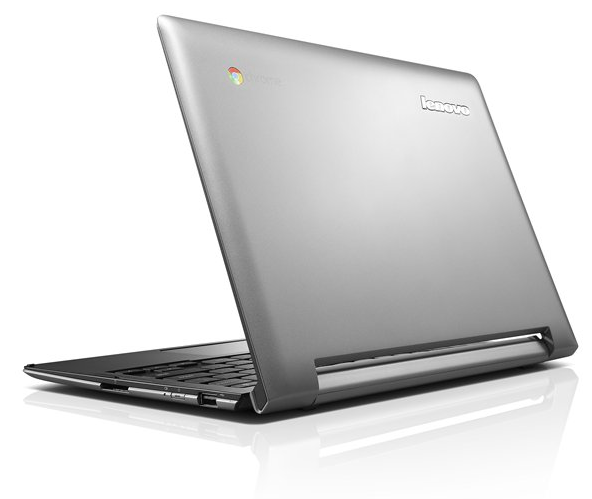Lenovo's New Chromebook Features 300-degree Hinge
Lenovo is expanding its Chromebook line with some consumer offerings.
Lenovo today unveiled its first consumer Chromebooks in the form of the N20 and the N20p. The former is a more traditional design, while the latter offers something a little bit more unique. The N20p is billed as a multimode laptop with a 300 degree hinge that allows both Laptop Mode and Stand Mode.
As far as size is concerned, both Chromebooks pack an 11.6-inch 1366 x 768 HD screen and a full-sized keyboard. They weigh roughly 3 lbs and measure 17.9 mm thick. The hardware specs are largely the same with a couple of key differences. They both run on Intel Celeron CPUs with integrated Intel Graphics and 4 GB of RAM. Check the table below for the full list of specs for both laptops:
| Spec | Lenovo Chromebook N20 | Lenovo Chromebook N20p |
|---|---|---|
| Processor | Intel Celeron | Intel Celeron |
| Operating System | Google Chrome OS | Google Chrome OS |
| Graphics | Intel Integrated Graphics | Intel Integrated Graphics |
| Display/Resolution | 11.6-inch HD display, 1366 x 768 | 11.6-inch HD display, 1366 x 768, 10-point multitouch |
| Memory | Up to 4 GB DDR3L | Up to 4 GB DDR3L |
| Storage | Up to 16 GB eMMC storage | Up to 16 GB eMMC storage |
| Sound | Stereo speakers; Audio Combo Jack (headphones and microphone) | Stereo speakers; Audio Combo Jack (headphones and microphone) |
| Wireless | Bluetooth 4.02; WiFi 802.11 a/c | Bluetooth 4.02; WiFi 802.11 a/c |
| Camera | Front: 1MP | Front: 1MP |
| Battery | Up to 8 hours | Up to 8 hours |
| Weight | 2.8 lbs | 3.1 lbs |
| Dimensions | 295 x 212 x 17.9 mm | 295 x 212 x 17.9 mm |
| Color | Graphite grey | Graphite grey |
| Connectors | 2 x USB ports, HDMI-out, 2-in-1 (SD/MMC) card reader | 2 x USB ports, HDMI-out, 2-in-1 (SD/MMC) card reader |
Pricing for the N20 and N20p starts at $279 and $329, respectively. The N20 will be available beginning in July, while the N20p will arrive in August. These laptops join Lenovo's ThinkPad 11e Chromebook and the ThinkPad YOGA 11e Chromebook in its Chromebook portfolio but are the first Chromebooks for consumers.
Follow Jane McEntegart @JaneMcEntegart. Follow us @tomshardware, on Facebook and on Google+.
Get Tom's Hardware's best news and in-depth reviews, straight to your inbox.

Jane McEntegart is a writer, editor, and marketing communications professional with 17 years of experience in the technology industry. She has written about a wide range of technology topics, including smartphones, tablets, and game consoles. Her articles have been published in Tom's Guide, Tom's Hardware, MobileSyrup, and Edge Up.
-
c123456 When will PC manufactures realize that people that want a tablet will buy a tablet, and people that want a laptop will buy a laptop? Trying to merge the two hasn't worked yet, nor will it ever work.Reply -
mouse24 ReplyWhen will PC manufactures realize that people that want a tablet will buy a tablet, and people that want a laptop will buy a laptop? Trying to merge the two hasn't worked yet, nor will it ever work.
What if you want both but your poor? -
c123456 $50 premium for the touchscreen interface. If you can't save another $50 for a decent tablet then I suppose you've got larger issues.Reply -
Chris Droste i don't think so, I think people not necessarily budget-constrained really don't want SEVERAL devices to carry around. it's happening right now between tablets and smartphones. i have the LG G2 with it's 5.2" 1080p display, and i have a Note 8.0, which i love both, but aside from the comfort of consuming media on the bigger screen and having the stylus options for a little "draw something!" and quick note taking, i really don't have a compelling reason to lug the Note 8.0 around. the G2 is crazy fast, the screen is great and it's already attached to a data network no matter where i got. same thing with a Hybrid laptop/tablet. do i want to carry around 2 devices if i can have one that will decently perform the job of both? no way, and the added benefit is i don't have to sync/move files between storage points, whether it be the cloud, locally, or data connection. i have an 8yr old toshiba laptop and i have a 5 year old netbook, and every time i look at replacements i lament the lack of ability a budget-minded model and scoff at the price of a nice ultrabook. at this stage I'm waiting for some impressive Tegra K1 device or something beyond bay trail (AMD Mullins, maybe?) to steal my attention and make me break out my wallet. My hopes currently rest on the HP android net-bookish...thing that was previewedReply -
Murissokah Sound like it could be a good enterprise solution for its low cost. It should be able to run anything we currently use in my company's workstations, for instance, but the fear of eventually needing to run windows code makes it a hard sell.Reply
As more people and companies look at alternatives to Microsoft's high cost and licensing nightmare, this may become a viable alternative at some point. Right now, I would pass.

